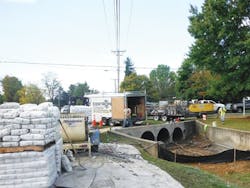Avoiding a Traffic Jam
Grottoes, Va., is a town of 2,600 people, and is notable for its proximity to Grand Caverns, America’s oldest show cave. As underground features go, Grand Caverns is a good one, but Grottoes also has the usual complement of underground infrastructure that makes any town work. In 2013, one significant asset, a large storm water system, was in trouble.
The Virginia Department of Transportation provides funding for the maintenance of streets and storm water networks, and as part of that arrangement, it requires the town to conduct annual inspections. In the last report, a large set of elliptical corrugated metal pipe (CMP) culverts did not pass inspection. “Our consultant, Schwartz & Associates, told us the culverts were in poor condition,” said Grottoes Town Manager Jeff Nicely. “They said there was severe corrosion, and that individual sections were failing and misaligned. They recommended replacement.”
The culverts in question were four parallel culverts, 70 by 44 in., that run directly underneath Dogwood Avenue, one of Grottoes’ two main thoroughfares. “It’s true, we’re a small town,” Nicely said. “Still, shutting down Dogwood would cause real problems for us. But maintenance of the culverts is our responsibility, and we had to do something.”
The town obtained cost estimates for trench-and-replace from Brunk & Hylton Eng. Inc. The cost was significant and the plan called for lengthy traffic disruptions. Then another idea occurred to Nicely: “At a Rural Water Assn. conference, we’d seen a process called CentriPipe that looked like it could be useful in this situation. The CentriPipe contractor in our area, Mike Shepherd, explained it to us, and we were very interested and asked Brunk & Hylton to look into it for us.”
System Benefits
The CentriPipe process is a centrifugally cast concrete pipe (CCCP) solution based on spincasting technology developed by AP/M Permaform. It was originally used in vertical applications, especially in manholes, but beginning in the 1990s, the process was refined for horizontal applications and now can be used for large-diameter pipe and sewer rehabilitation. In essence, the CentriPipe spincaster is pulled back through failing pipe while spraying strong, highly adhesive, fiber-reinforced cementitious grout onto the pipe in thin layers. As the layers accrete, typically to a design thickness of around 2 in., they form a new, structurally sound concrete pipe within the old pipe.
This system has several advantages. Because it is an intrinsically structural solution, the structural strength of the failing sewer is immaterial—it just has to stay in place long enough to act as a substrate for the new concrete pipe. And because the new pipe is thin and adheres tightly to the existing pipe or culvert—the material used, PL-8000 from AP/M Permaform, adheres to metal, clay, brick and high-density polyethylene—sewer flow capacity is minimally affected, and no annular space is left between the old and new pipe, so there is no groundwater or storm water flow in that area. It also is trenchless.
“Compared just on project cost, using CentriPipe was 15% cheaper than digging up the old sewers and replacing them,” Nicely said. “But that doesn’t even account for the savings gained by not disrupting traffic for weeks.” Nicely estimated that avoiding the costs of traffic monitoring saved another 5% or so, and said that saving the town the hassle of disrupted traffic is an incalculable but significant benefit. The lengthy permitting process also may have been eased by the relative lack of disruption and excavation.
Phased Installation
Mike Shepherd’s crew at D&S Contractors and Arold Construction, both licensees of AP/M Permaform, did the work in two phases. Shepherd said the project was straightforward: “There were four parallel culverts, 112 ft long, for a total of 448 ln ft. Fortunately, the CMP wasn’t actually falling apart, so no spot repairs had to be done prior to casting the new pipe, we didn’t have to pour a new invert, and we did the work in a dry month, so dewatering wasn’t an issue.”
The crews cleaned the culverts using the CentriPipe spincaster as a high-pressure washer to clear out debris that could affect adhesion. They then made multiple passes, pulling the spincaster on skids and pumping PL-8000 that was mixed on site (the material is dry and was delivered to the staging area in bags) to build up a final thickness of 2 in. This dimension and other specifications were established by consulting engineers contracted by AP/M Permaform.
Quality control was performed in two ways, Nicely said. The thickness of the new pipe was the key factor: “We measured the old CMP from the top of the corrugations and compared that with the finished product,” Nicely said. “And we also drilled several holes along the new concrete, to verify thickness. Everything was to specification.”
The work was completed in 2014 and the new culverts are smooth, seamless, watertight and structurally stronger than the old CMP, with longer projected service life. “We’re happy with the results,” Nicely said. “Best of all, we never had to stop traffic.”
Download: Here
